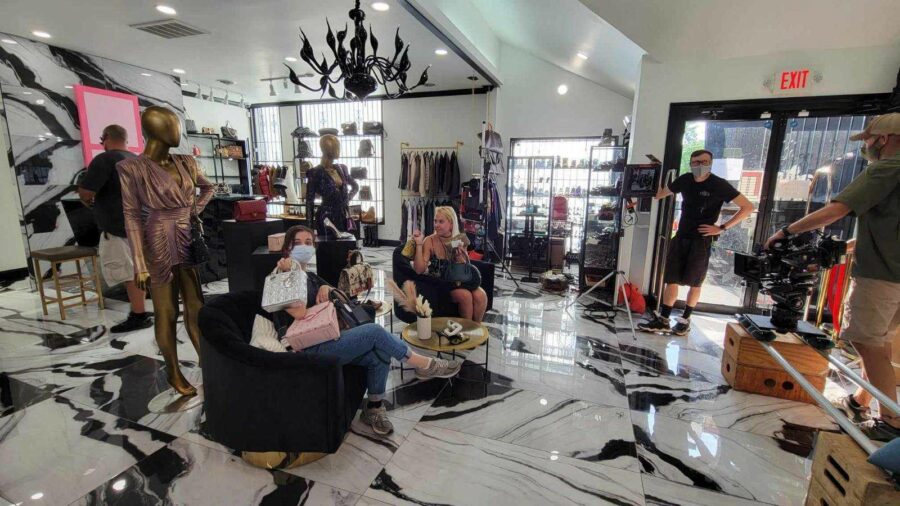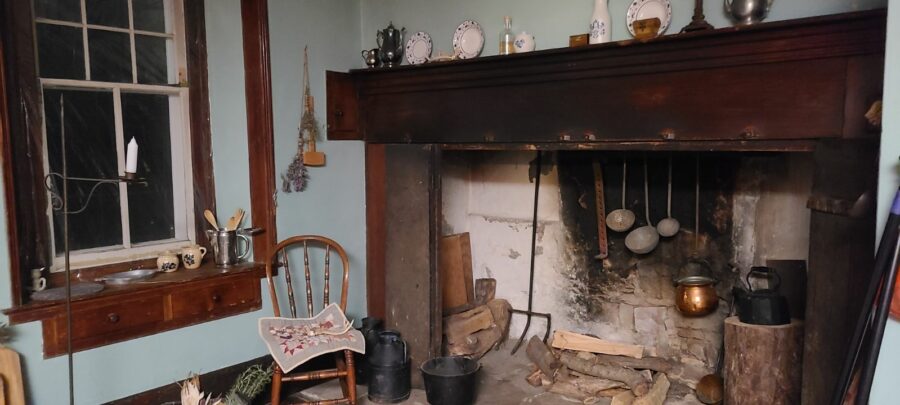A Conversation With Caitlin King
From the time she was a little girl, Caitlin King wanted to immerse herself in the world of storytelling. In the midst of all the intricate roles that make up the magnificent process that is filmmaking, Caitlin found herself longing to be a part of crafting the film’s unique and stylized world.
Starting out with aspirations as a director, Caitlin discovered an area of film that called to her more than anything had before: the art department.
“From the time I was 5, I very much so wanted to be in the worlds that I saw in movies and on TV. Once I got a little older and realized that there are writers, directors, and lots of other people that create that world, I knew that’s what I wanted to do,” she said.
This revelation didn’t immediately lead Caitlin to the art department. Like most young filmmakers, she started expanding her knowledge of all the key elements of production. She became involved in her high school’s media program, winning the Greenfield Film Festival two years in a row, for her documentary and experimental short films.
With these accolades and experience to her name all the while still being a teenager, Caitlin ventured to Drexel University where she got her Bachelor’s of Science in Film and Video Production, becoming what she calls a “cinematic engineer.”
Known for their hands-on approach and emphasis on the technical aspects of creative processes, Caitlin spent most of her time on sets and working with various equipment at Drexel and learned extensively about the critical details that create that atmosphere of a film.
Starting out as a production assistant, Caitlin worked her way up to Production Designer. Over the course of her career, she has worked on a variety of shows and movies such as RuPaul’s Drag Race as Queen Handler, Ellen’s Next Top Designer as an Associate Producer, and A Party To Die For as an Art Director/Production Designer.
 On the set of A Party To Die For
On the set of A Party To Die For
“People think that directors are auteurs but filmmaking is a team sport. A good director is like a good coach. They guide and coordinate the team to harness the creative energy of all the artists working for them,” Caitlin said.
Being someone who has worked with a variety of people all with individual talents and roles in the filmmaking process, Caitlin also acknowledges the collaborative efforts of everyone to create an awe-inspiring world that brings intention and vision to life.
“It’s very much a team effort. It’s not physically possible for one person to do all of it. Everybody brings their creative energy…it is so much more collaborative than people realize because we’re all feeding off of each other’s energy.”
Now as a production designer, Caitlin is designing the worlds that she once envisioned herself in as a kid. Working with the writer and directors, she takes their stories and designs the set pieces, bringing her knowledge of filmmaking and design together, to create immersive worlds for the characters to live in.
“The director tells me about the characters, the story’s intentions, and themes similar to how they might talk to an actor but more about the aesthetics. I will take that and run with it. When I am designing sets, I am always keeping in mind what story elements need to be conveyed to the audience to tell the story most effectively.”
Building these worlds and environments that serve not just as a physical space occupied by the characters but as a way of executing the intended themes and messages of the film can be a daunting task. Caitlin’s approach involves dissecting every meticulous detail and its significance so she can understand what needs to be created and why.
“I start with some basic questions: What information does the audience need to understand the space? How can I reflect the character’s personality in the space they live in? How do they use the space, and what can we do to make it feel more authentically lived-in? Every movie is different, so of course these questions can change depending on the film.”
Caitlin also goes above and beyond by curating specific design choices that incorporate symbolism to enhance the metaphor of the scene and the space contained within the scene. Her keen observation and implementation of these details accurately and thoughtfully portray the messages that need to be conveyed.
“I started to think about the color palette and the psychology of the different uses of color. It’s similar to the creative process of interior decorating but we are creating a temporary lived-in space that will only be seen as a flat 2D image.”
Caitlin has found herself journeying to numerous thrift stores and antique shops to find each and every minuscule detail that will add to the project’s aesthetic. While thrifted pieces offer a sense of authenticity and help emphasize that lived-in look, sometimes completely new props and sets are necessary for the final product.
“Everything that you see in the movie we have to build in some capacity. Even when we shoot on location they’ll have a big empty house for us and our job is to fill it with everything you see on screen and sometimes with things you don’t. I have been very lucky to work with some amazingly talented art crew, who are brilliant at what they do and fun to work with.”
Caitlin’s specialties don’t lie in one particular place, however, as she and her team have worked on a variety of projects from glamorous to haunting. The designer’s behind-the-scenes pictures on Instagram reveal the immaculate attention to detail in each set design.
For indie-horror film Impuratus, the art department delivered an intensely terrifying set, ripped right out of the Civil War era. Using rusted chains, cracked wood, and a palette consisting of dark reds and deep blues, viewers were transported back in time and witnessed the firsthand suffering of Jody Quigley’s Daniel Glassman, a soldier facing unimaginable horror.
 On the set of Impuratus
On the set of Impuratus
In contrast, A Party To Die For follows two fashionable young women who must cover up a murder. The film’s LA setting prompted Caitlin to craft a glitzy mood board that looks almost indistinguishable from the final scene, complete with Barbie-esq fashions, black and white marble floors, and gold mannequins.
“They were very different projects with very different intentions. Honestly, every project is so different, it’s really difficult to compare,” Caitlin said. Even with disparate projects, one being a horror film and the other being a stylistic thriller, Caitlin and the rest of the art department are dedicated to emulating a distinct style and vibe.
“I work with some incredibly talented and hardworking people. I know that whatever the story we are telling, me and my team will be able to bring the fire and create something great,” she adds.
Of course, the ongoing WGA/SAG-AFTRA strike has slowed things down for Caitlin and others working in the art department, who hope to continue the work that inspires them soon. Audiences everywhere too are longing for more immaculate creations displayed in their favorite films and TV shows.
While the center of the strike is fixated on the writers and actors, many forget that all other crew members are affected by the halt in production, resulting in a huge job loss for those in the entertainment industry.
“[We] support the strike. I am very grateful that the writers and actors are taking up this fight to protect the artistic integrity of our work and for appropriate compensation for what our work contributes to society.”
Despite this prolonged absence of production, Caitlin remains optimistic about the future of film and television and hopes that the audience’s desire to see their favorite shows and new films will help kickstart the next generation of entertainment once better working conditions and pay are established fairly.
“What I’m really hoping is that when the strike is over we’ll get back to work immediately. There will be so much pent-up demand for production and content that we’ll have a ton of movies and shows ready to get going right away,” she said.
Even in the face of unemployment and unpromising comments from studio CEOs, there is an immense amount of support between industry workers, proving that collaboration and alliance are just as vital off-set as on.

